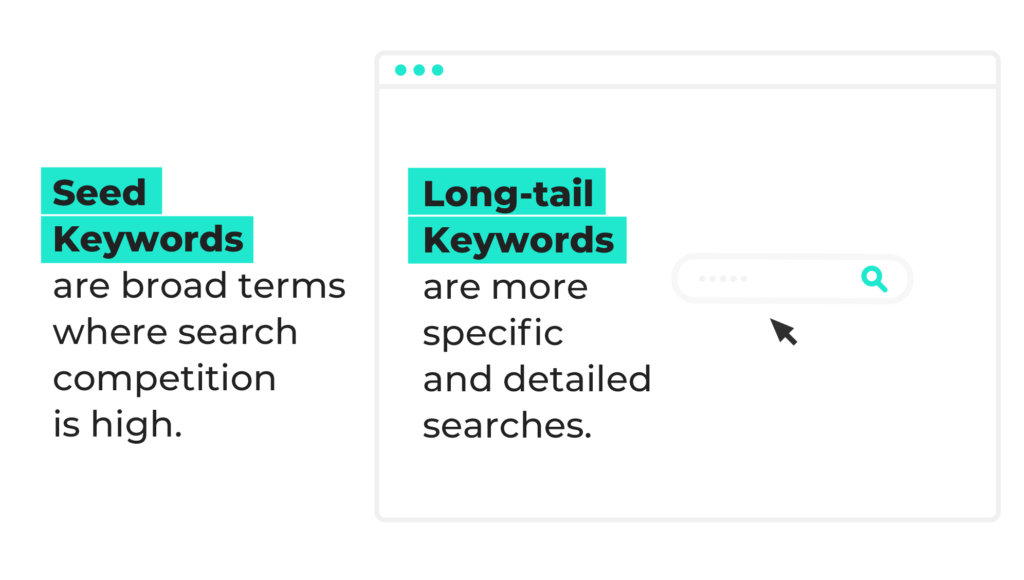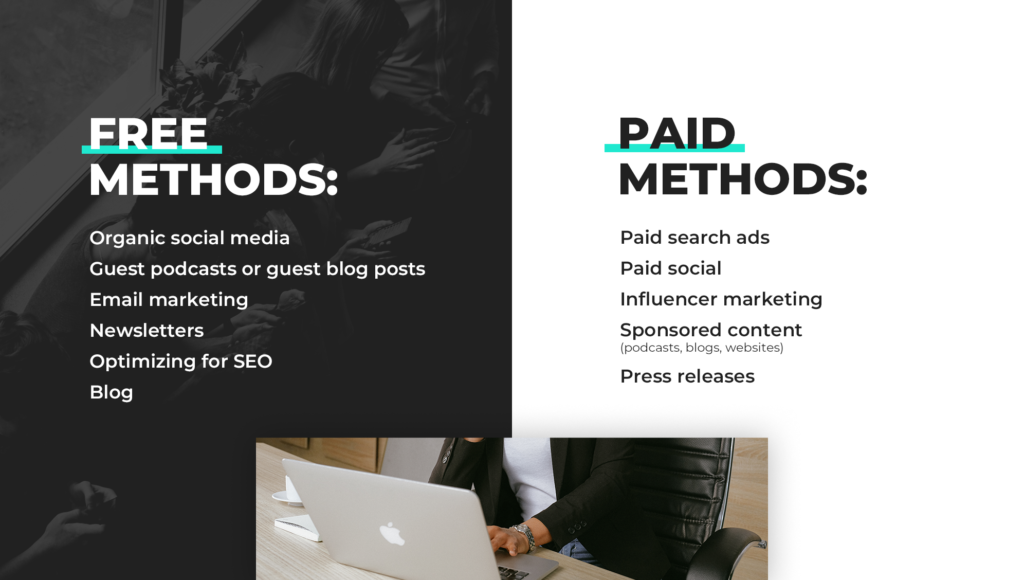
What is content marketing?
Before going into SEO content strategy, let’s look at what content marketing is in the first place. It’s the creation and sharing of content to an intended end consumer with the goals of providing value and prompting action. Content can come in text, video, audio, or imagery and through various communication channels such as a company blog, social media, marketing videos, and podcasts.
What about SEO content marketing?
Having a content strategy specifically for SEO increases the likelihood that your website will be in the top search engine results for Google, Bing, Baidu, Yahoo, or others. Your company will benefit from an SEO strategy by being more aligned, prioritizing what is of value, and holding your team to accountability. Next, we’re going to get right into the best practices for creating your company SEO strategy.
8 Steps to Build a SEO Content Strategy
1) Identify business goals and customers you want to reach
Set your business goals first and then figure out how your content can then support them. Is your main objective to grow audiences, retain existing ones, increase revenue, or increase traffic to your website? Also, make sure to take a look at the type of audience you want to reach. Do you want to increase your demographic, expand your demographic, or move into a new demographic completely? It is important to understand that to achieve your business goals through content strategy, it is not just going to take one avenue but many avenues to get there.
2) Closely identify your audience and their problems
What does your company solve and who has the problems it solves? Talk to your internal departments that have the most customer facing positions like customer service, sales, product, social media, and tech support. Listen to your audience on social media and analyze your customer demographics. You can also conduct qualitative research, send surveys to your customers via email marketing, social media strategy, or push notifications.
In the Case study: The Motley Fool — addressing the pain points of recent college grads, they gave the following example of choosing an audience, identifying their problems and the job to be done. The case study found the problem to be; student loans, high cost of living, and a lack of knowledge to get in control of your finances is a block for graduating students. The job? Provide help for graduating students to learn how to manage money so they can successfully live on their own.
What would a content strategy look like to cover those problems and job? Blog articles, social media posts, YouTube videos and IGTV live Q and A’s on the following topics:
- How to get out of student loan debt in 10 years or less
- How much of your income should go towards housing?
- How to build a budget
- How to negotiate your first raise
- How much income to put away for retirement in your 20s
3) Mix up your content
The goal of content? Create valuable, engaging, and unique content that speaks to your audience and is different from your competitors. Remember, you don’t need to be everything to everyone, you just need to be valuable to your audience. Try writing down your audience’s problems on the left side of a paper, and your brand’s knowledge and services on the other, the cross-over or what is between those is the content angle you should go with.
4) SEO content strategy or in other words, conduct keyword research
What is keyword research? Learning how people search for particular topics or concepts utilizing tools for SEO. For your company’s SEO strategy, the goal of keyword research is to identify the language that your target audience uses to describe its problems, which your company solves. Once you know that language, that is what you should use in your content.
Some free keyword research tools are:
- Keywords Everywhere (a Chrome and Firefox browser add-on)
- Wordtracker
- Ubersuggest (from online marketing expert Neil Patel)
- AnswerThePublic
- Google Trends
As always, paid will usually get you more in terms of value than any free site will. Below are some of our favorite paid keyword research tools to use:
For every keyword you find relative to your audience, create content around that word and dive deep into the subject matter. Create content that uses both seed keywords and long-tail keywords.

Referring back to the case study: The Motley Fool — identifying content marketing keywords for “student loan debt,” the case study utilizes the keyword: student loan and sees that it can break off into multiple topics such as, “student loan consolidation,” “student loan calculator,” “average student loan debt,” “how to pay off student loan debt” and “how to refinance student loans.” These are now the long-tail keywords.
5) What types of content should you produce?
When deciding what types of content to produce from your keyword research, ask yourself the following questions.
- What content is working for your competitors?
- What type of content can you realistically produce with your skill set, team and resources?
When you are ready to start creating, decide who is going to be responsible for this. Do you have an in-house employee with the right skill sets needed? If not, you can hire an agency or freelancer to create the content you need for your brand.
6) Create a marketing distribution plan
Write down the types of content you are going to create that align with your business goal and SEO strategy. If your goal is new traffic, try getting on guest podcasts/blogs, organic SEO and social media, paid ads (both search and social media) and releasing a press release. The below is a break down of both free and paid distribution methods.

7) Create an editorial calendar
Search-optimized content editorial calendars should include the following:
- Publish date for the piece of content
- Author
- Title
- Target keywords addressed in the content
- Main points
- Product line (which product line, service or seed keyword the content is supporting)
- Target audience
- Call to action (CTA) (what your content prompts the audience to do next: learn more, buy this product, enjoy the next piece of content, etc.)
- Amplification channels
Next, place all of the above content into a management system so you and your team can collaborate and work together on creation and execution. Our favorite task management systems are:
8) Publish your SEO content and track analytics closely
Depending on the type of content you publish will determine what metrics you want to measure.
For social media content, organic or paid, look at the following:
- Audience Growth
- Reach
- Engagement
- Conversion/purchases
- Link clicks
- Saves
- Shares
You can track these by using services such as Hootsuite, Sprout Social, Facebook Analytics or your favorite social media scheduling system.
For the majority of other key content measures, look at:
- Sessions
- Page views
- Email leads/registrations
- Purchases
- Pages per session
- Time on page or scroll depth
- Bounce rate
You can track these mainly using Google Analytics. Goal setting, a tool in Google Analytics, allows you to compare website traffic to customer behavior. If you are running a campaign, we suggest using Google’s Campaign URL Builder.
We hope this blog post provided you a guideline to creating your company’s SEO content strategy. If you are ready to bring in an agency to ramp up your SEO strategy and content creation, contact us at Get Knowticed so we can align you with the team for the job.




